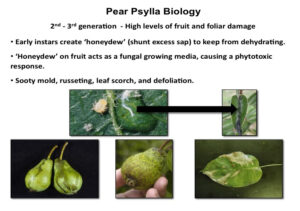Pear Psylla: The next generation (Gen 2)

If your scouting in pears this week you will likely be finding large numbers of adults, new white eggs, older 5th instar and newly hatching 1st instar nymphs. This period of the season is when 1st and 2nd generation of pear psylla population numbers overlap and skyrocket. We are approaching the most difficult part of the year to control psylla due to increasing foliage leading to insecticide shadowing, and weeks of egg laying onto the newest leaves containing very little insecticide residue. The pear psylla, which have the greater potential to survive into the 3rd generation, are those dwelling in the center and very tops of the trees, well protected from control measures. The concentrated sugars that psylla produce, in the form of ‘honeydew’ or droppings, will act as a substrate for sooty mold to grow on foliage and fruit. The mold will cause a phytotoxic response on foliage in the form of leaf scorch and fruit russet, leading to early defoliation and smaller discolored and misshapen fruit.
Cultural controls should begin over the next two weeks as egg laying will begin in earnest. Most of the eggs will be laid at the tips of newly developed leaves, onto water sprouts, extension shoots and suckers. These can be easily removed by hand for the next few weeks by simply breaking them off at the base. Fireblight will be an issue in pears with removal of suckers limited to dry weather for quick healing…never before a rain event.
Control of pear psylla at this early stage of development is critical. There are a number of excellent products to use against pear psylla which include the insect growth regulator Centaur, the neonicotinoids Actara and Assail (used with 0.25% oil), Delegate (to also reduce codling moth). I would shy away from pyrethroids in warmer weather as it appears that the psyllid can more easily detoxify this class of insecticides in warmer weather (>80F).
Agri-Mek® remains one of the backbone products for pear psylla and pear rust mite management, still very effective at managing this complex as a locally systemic insecticide. It works best if applied at this point in time as foliage has not hardened significantly to reduce uptake. Agri-Mek® 8SC (Syngenta) is a new water based formulation of abamectin, employing increased concentration (8.0% Abamectin) for lower use rates between 2.25 and 4.25 fl.oz./A. It replaces the long standing Agri-Mek 0.15 EC formulation (2.0% Abamectin) used at a rate of 10-20 fl.oz./A, both formulations in IRAC’s Group 6 mode of action. Both of these formulations MUST ALWAYS be mixed with a penetrating non-ionic surfactant; such as in combination with horticultural spray oil used at 0.25%, to be effective. And applications of Agri-Mek without a penetrating surfactant will likely result in significant reduction in the efficacy and/or residual control of the insect and mite population.
We have found the use of 1% oil in 10 to 14 day applications to reduce psylla during the course of the summer while helping to reduce the leaf drop associated with Fabraea leaf spot. The advantages of using oil to control this insect are many. Oil is still a relatively inexpensive material for which there has been no mechanism for resistance development by the insect. Oil in a 1% dilute application provides a degree of egg laying deterrence to foliage and early stage nymph mortality lasting a week or two depending on rates and weathering. This rate will also reduce emerging populations of San Jose scale, European red mite, pear leaf blister mite, and Comstock mealybug. Oil droplets will cause some mortality to the adult while applications over top of the egg will reduce adhesion, often causing them to dislodge from the tree. Negative observable impact of oil applications has been shown to cause enlarged lenticels on developing stems, which may have impact of plant respiration. Use of oil should be limited to fast dry times and cooler temperatures (<80F). Given the need for Fabraea management on a 10-14 day schedule, its likely that oil at 1% would help in psylla management employed in a tank mix with your fungicide.
To knock back newly emerging psylla adults, Actara with 0.25% oil has been shown to reduce adult psylla populations better then other neonicotinoids with translaminar feeding and contact efficacy against the nymph.
Codling Moth (CM): adults have been captured in Highland on the 19th of May and may also be a problem in pear blocks this week. The first eggs hatch after about 220 DD, which is predicted to occur 3 June. If you choose to use AgriMek or Actara for psylla management, then a material for CM should be strongly considered. CM specific insecticides can be employed such as Altacor, Assail, Belt, Delegate, Lannate, and the pyrethroid group. Delegate will also provide control of psylla when used against the CM.
